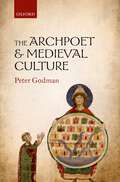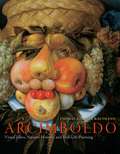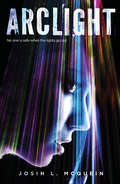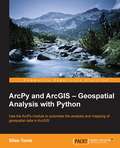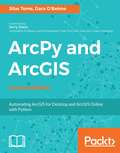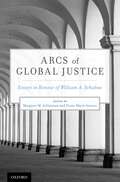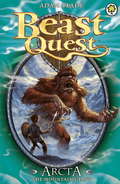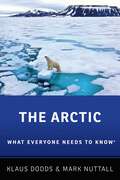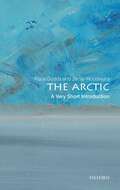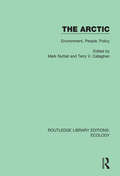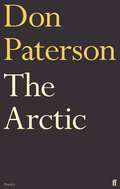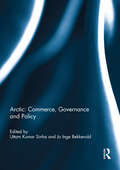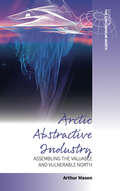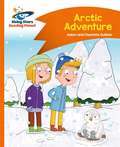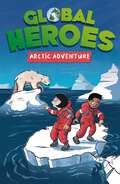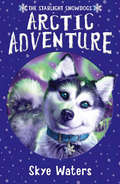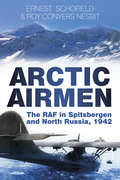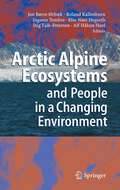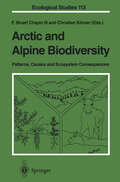- Table View
- List View
The Archpoet and Medieval Culture
by Peter GodmanThis is the first monograph to be published about one of the most famous and least understood authors of the Latin Middle Ages. We know him by the pseudonym of Archpoet. Setting the Archpoet's world and works in their historical contexts, Peter Godman argues that they provide insight into a brilliant counter-culture of medieval Germany. Its subtlest exponent did not indulge in literary play but refashioned the political, social, and religious roles available to a twelfth-century thinker in order to create, for himself and his patron, an identity alternative to the norms of clerical conformity prevalent elsewhere in Europe. At a time when Germans were being decried as backward barbarians, he produced a manifesto of intellectual heterodoxy which wittily challenged the truth-claims made by humourless moralists. The Archpoet and Medieval Culture reconsiders the categoriesin which the literature of the Middle Ages is interpreted and suggests a less literal mode of reading the sources to historians.
Arcimboldo: Visual Jokes, Natural History, and Still-Life Painting
by Thomas DaCosta KaufmannIn Giuseppe Arcimboldo’s most famous paintings, grapes, fish, and even the beaks of birds form human hair. A pear stands in for a man’s chin. Citrus fruits sprout from a tree trunk that doubles as a neck. All sorts of natural phenomena come together on canvas and panel to assemble the strange heads and faces that constitute one of Renaissance art’s most striking oeuvres. The first major study in a generation of the artist behind these remarkable paintings, Arcimboldo tells the singular story of their creation. Drawing on his thirty-five-year engagement with the artist, Thomas DaCosta Kaufmann begins with an overview of Arcimboldo’s life and work, exploring the artist’s early years in sixteenth-century Lombardy, his grounding in Leonardesque traditions, and his tenure as a Habsburg court portraitist in Vienna and Prague. Arcimboldo then trains its focus on the celebrated composite heads, approaching them as visual jokes with serious underpinnings—images that poetically display pictorial wit while conveying an allegorical message. In addition to probing the humanistic, literary, and philosophical dimensions of these pieces, Kaufmann explains that they embody their creator’s continuous engagement with nature painting and natural history. He reveals, in fact, that Arcimboldo painted many more nature studies than scholars have realized—a finding that significantly deepens current interpretations of the composite heads. Demonstrating the previously overlooked importance of these works to natural history and still-life painting, Arcimboldo finally restores the artist’s fantastic visual jokes to their rightful place in the history of both science and art.
Arclight (Arclight #1)
by Josin L McQuein'Arclight will keep you up all night, if you dare to stay awake.' – Pittacus Lore, author of New York Times best-seller I am Number Four. No one is safe when the lights go out – a sci-fi thriller you shouldn’t read in the dark…
ArcPy and ArcGIS – Geospatial Analysis with Python
by Silas TomsIf you are a GIS student or professional who needs an understanding of how to use ArcPy to reduce repetitive tasks and perform analysis faster, this book is for you. It is also a valuable book for Python programmers who want to understand how to automate geospatial analyses.
ArcPy and ArcGIS - Second Edition
by Silas Toms Dara O'BeirneUse Python modules such as ArcPy, ArcREST and the ArcGIS API for Python to automate the analysis and mapping of geospatial data. About This Book • Perform GIS analysis faster by automating tasks. • Access the spatial data contained within shapefiles and geodatabases and transform between spatial reference systems. • Automate the mapping of geospatial analyses and production of map books. Who This Book Is For If you are a GIS student or professional who needs an understanding of how to use ArcPy to reduce repetitive tasks and perform analysis faster, this book is for you. It is also a valuable book for Python programmers who want to understand how to automate geospatial analyses and implement ArcGIS Online data management. What You Will Learn • Understand how to integrate Python into ArcGIS and make GIS analysis faster and easier. • Create Python script using ArcGIS ModelBuilder. • Learn to use ArcGIS online feature services and the basics of the ArcGIS REST API • Understand the unique Python environment that is new with ArcGIS Pro • Learn about the new ArcGIS Python API and how to use Anaconda and Jupyter with it • Learn to control ArcGIS Enterprise using ArcPy In Detail ArcGIS allows for complex analyses of geographic information. The ArcPy module is used to script these ArcGIS analyses, providing a productive way to perform geo-analyses and automate map production. The second edition of the book focuses on new Python tools, such as the ArcGIS API for Python. Using Python, this book will guide you from basic Python scripting to advanced ArcPy script tools. This book starts off with setting up your Python environment for ArcGIS automation. Then you will learn how to output maps using ArcPy in MXD and update feature class in a geodatabase using arcpy and ArcGIS Online. Next, you will be introduced to ArcREST library followed by examples on querying, updating and manipulating ArcGIS Online feature services. Further, you will be enabling your scripts in the browser and directly interacting with ArcGIS Online using Jupyter notebook. Finally, you can learn ways to use of ArcPy to control ArcGIS Enterprise and explore topics on deployments, data quality assurances, data updates, version control, and editing safeguards. By the end of the book, you will be equipped with the knowledge required to create automated analysis with administration reducing the time-consuming nature of GIS. Style and approach The book takes a pragmatic approach, showing ways to automate repetitive tasks and utilizing features of ArcPy with ArcGIS Pro and ArcGIS online.
Arcs of Global Justice: Essays in Honour of William A. Schabas
by Margaret M. deGuzman and Diane Marie AmannMartin Luther King, Jr. once said 'the arc of the moral universe is long, but it bends toward justice.' Testing the optimism of that claim were the many fits and starts in the struggle for human rights that King helped to catalyze. The same is true of other events in the last half-century, from resistance to apartheid and genocide to equal and fair treatment in domestic criminal justice systems, to the formation of entities to prevent atrocities and to bring their perpetrators to justice. Within this display of myriad arcs may be found the many persons who helped shape this half-century of global justice-and prominent among them is William A. Schabas. His panoramic scholarship includes dozens of books and hundreds of articles, and he also has served as an influential policymaker, advocate, and mentor. This work honours William A. Schabas and his career with essays by luminary scholars and jurists from Africa, Asia, Europe, and the Americas. The essays examine contemporary, historical, cultural, and theoretical aspects of the many arcs of global justice with which Professor Schabas has engaged, in fields including public international law, human rights, transitional justice, international criminal law, and capital punishment.
Arcs of Global Justice: Essays in Honour of William A. Schabas
Martin Luther King, Jr. once said 'the arc of the moral universe is long, but it bends toward justice.' Testing the optimism of that claim were the many fits and starts in the struggle for human rights that King helped to catalyze. The same is true of other events in the last half-century, from resistance to apartheid and genocide to equal and fair treatment in domestic criminal justice systems, to the formation of entities to prevent atrocities and to bring their perpetrators to justice. Within this display of myriad arcs may be found the many persons who helped shape this half-century of global justice-and prominent among them is William A. Schabas. His panoramic scholarship includes dozens of books and hundreds of articles, and he also has served as an influential policymaker, advocate, and mentor. This work honours William A. Schabas and his career with essays by luminary scholars and jurists from Africa, Asia, Europe, and the Americas. The essays examine contemporary, historical, cultural, and theoretical aspects of the many arcs of global justice with which Professor Schabas has engaged, in fields including public international law, human rights, transitional justice, international criminal law, and capital punishment.
Arcta the Mountain Giant: Series 1 Book 3 (Beast Quest #Bk. 3)
by Adam BladeBattle fearsome beasts and fight evil with Tom and Elenna in the bestselling adventure series for boys and girls aged 7 and up. An evil wizard has enchanted the magical Beasts of Avantia - only a true hero can free the Beasts and stop them from destroying the land. Armed with a sword and shield from the Wizard Aduro, Tom sets off to face Arcta the mountain giant. Can Tom save his land from destruction?There are SIX thrilling adventures to collect in Series One: Sepron the Sea Serpent; Arcta the Mountain Goat; Nanook the Snow Monster; Tagus the Horse-Man; and Epos the Flame BirdIf you like Beast Quest, check out Adam Blade's other series: Team Hero, Sea Quest and Beast Quest: New Blood!
The Arctic: What Everyone Needs to Know® (What Everyone Needs To Know®)
by Klaus Dodds Mark NuttallConversations defining the Arctic region often provoke debate and controversy -- for scientists, this lies in the imprecise and imaginary line known as the Arctic Circle; for countries like Canada, Russia, the United States, and Denmark, such discussions are based in competition for land and resources; for indigenous communities, those discussions are also rooted in issues of rights. These shifting lines are only made murkier by the threat of global climate change. In the Arctic Ocean, the consequences of Earth's warming trend are most immediately observable in the multi-year and perennial ice that has begun to melt, which threatens ice-dependent microorganisms and, eventually, will disrupt all of Arctic life and raise sea levels globally. In The Arctic: What Everyone Needs to Know®, Klaus Dodds and Mark Nuttall offer concise answers to the myriad questions that arise when looking at the circumpolar North. They focus on its peoples, politics, environment, resource development, and conservation to provide critical information about how changes there can, and will, affect our entire globe and all of its inhabitants. Dodds and Nuttall explore how the Arctic's importance has grown over time, the region's role during the Cold War, indigenous communities and their history, and the past and future of the Arctic's governance, among other crucial topics.
The Arctic: What Everyone Needs To Know® (Very Short Introductions)
by Klaus Dodds Jamie WoodwardVery Short Introductions: Brilliant, Sharp, Inspiring The Arctic is demanding global attention. It is warming, melting, and thawing in a manner that threatens fundamental state-change. For communities that call the Arctic 'home' this is unwelcome. A warming Arctic brings with it the spectre of costly disruption and interference in indigenous lives and communal welfare. For others, the disappearance of sea ice makes the Arctic appear more accessible and less remote. This also brings with it dangers such as the prospect of a new era of great power rivalries involving China, Russia, and the United States. Submarine and long-range bomber patrolling are now commonplace. New terms such as 'global Arctic' are being used to capture the dynamic of change while others muse about the 'return of a Cold War'. The reality is inevitably more complex. The physical geography of the Arctic is highly varied and variable. Environmental change brings opportunities for indigenous and non-indigenous life-forms to survive and even thrive. The Arctic's four million people are not helpless pawns in a game of global geopolitics. The Arctic is not only a resource hotspot but also a place where sustainable energy systems are being introduced. A warming Arctic with less ice and permafrost is not unique in the longer history of the Earth either. The Arctic is a complex space. In this Very Short Introduction, Klaus Dodds and Jamie Woodward consider the major dimensions of the region and the linkages beyond - from the geopolitical to the environmental. They examine the causes, drivers, and effects of cultural, physical, political, and economic change, and ponder the future of the Arctic. As they show, it is a future which will affect us all. ABOUT THE SERIES: The Very Short Introductions series from Oxford University Press contains hundreds of titles in almost every subject area. These pocket-sized books are the perfect way to get ahead in a new subject quickly. Our expert authors combine facts, analysis, perspective, new ideas, and enthusiasm to make interesting and challenging topics highly readable.
The Arctic: Environment, People, Policy (Routledge Library Editions: Ecology #10)
by Mark Nuttall; Terry V. CallaghanOriginally published in 2000, The Arctic provides a comprehensive overview of the region's rapidly changing physical and human dimensions, and demonstrates the importance of communication between natural scientists, social scientists, and local stakeholders in response to the tremendous challenges and opportunities facing the Arctic. It is an essential resource for all Arctic researchers, particularly those developing multidisciplinary projects. It provides an overview of key areas of Arctic research by renowned specialists in the field, and each chapter forms a detailed, varied and accessible account of current knowledge. Each author introduces the subject to a specialist readership, while retaining intellectual integrity and relevance for specialists. Overall, the richness of the material presented in this volume reflects the ecological and cultural diversity of this vast and environmentally critical part of the globe.
The Arctic: Environment, People, Policy (Routledge Library Editions: Ecology #10)
by Mark Nuttall Terry V. CallaghanOriginally published in 2000, The Arctic provides a comprehensive overview of the region's rapidly changing physical and human dimensions, and demonstrates the importance of communication between natural scientists, social scientists, and local stakeholders in response to the tremendous challenges and opportunities facing the Arctic. It is an essential resource for all Arctic researchers, particularly those developing multidisciplinary projects. It provides an overview of key areas of Arctic research by renowned specialists in the field, and each chapter forms a detailed, varied and accessible account of current knowledge. Each author introduces the subject to a specialist readership, while retaining intellectual integrity and relevance for specialists. Overall, the richness of the material presented in this volume reflects the ecological and cultural diversity of this vast and environmentally critical part of the globe.
The Arctic
by Don PatersonIn this new collection from Don Paterson, 'The Arctic' is the bar frequented in the backstreet of a post-apocalyptic world. Under its echoey aegis are gathered poems about men and women, polemical responses to a pandemic, microdot poems, odes to dogs, to movies and the male anatomy, and, in the chill undertow, a series of poems that mourn the poet's musician father. Other poets are drawn in from the cold, including the Chilean poet, Gabriela Mistral, whose verses are magically transformed to Paterson's native Scots; there are versions, too, of Cavafy, Montale and Unamuno. And in the fourth part Paterson's ongoing long poem 'The Alexandrian Library', travelling from a weather station at the top of Ben Nevis to the cellar back at The Arctic Bar, we are witness to the imminence of man-made extinction. By turn, urgent, railing, tender, these are poems for our times, by one of our most celebrated and formally adventurous poets.
Arctic: Commerce, Governance And Policy
by Uttam Kumar Sinha Jo Inge BekkevoldIn May 2013, China, India, Japan, Singapore and South Korea (Asia 5) were given status as permanent observers in the Arctic Council. It was a symbolic and significant moment in the history of Arctic affairs. The list of stakeholders in the Arctic has now expanded to include both the Arctic littoral states and the five Asian states. The drivers and policies of these stakeholders on the Arctic vary, but research on climate change, possible changes to the global energy and minerals markets, adherence to international norms like the UNCLOS, and geopolitical considerations are issues of concern. This volume is based on the reviewed, revised and updated versions of papers presented at the roundtable on The Geopolitics of the Arctic: Commerce, Governance and Policy hosted by the Institute for Defense Studies and Analyses (IDSA) in New Delhi in September, 2013, in joint co-operation with the Fridtjof Nansen Institute (FNI), the Norwegian Institute for Defence Studies (IFS) and Peace Research Institute Oslo (PRIO).We hope that this book, with some compelling perspectives on a number of challenging issues, will help engage the policy community to identify and explore opportunities for international cooperation in the Arctic. This book was originally published as a special issue of Strategic Analysis.
Arctic: Commerce, Governance And Policy
by Uttam Kumar Sinha and Jo Inge BekkevoldIn May 2013, China, India, Japan, Singapore and South Korea (Asia 5) were given status as permanent observers in the Arctic Council. It was a symbolic and significant moment in the history of Arctic affairs. The list of stakeholders in the Arctic has now expanded to include both the Arctic littoral states and the five Asian states. The drivers and policies of these stakeholders on the Arctic vary, but research on climate change, possible changes to the global energy and minerals markets, adherence to international norms like the UNCLOS, and geopolitical considerations are issues of concern. This volume is based on the reviewed, revised and updated versions of papers presented at the roundtable on The Geopolitics of the Arctic: Commerce, Governance and Policy hosted by the Institute for Defense Studies and Analyses (IDSA) in New Delhi in September, 2013, in joint co-operation with the Fridtjof Nansen Institute (FNI), the Norwegian Institute for Defence Studies (IFS) and Peace Research Institute Oslo (PRIO).We hope that this book, with some compelling perspectives on a number of challenging issues, will help engage the policy community to identify and explore opportunities for international cooperation in the Arctic. This book was originally published as a special issue of Strategic Analysis.
The Arctic: A Very Short Introduction (Very Short Introductions)
by Klaus Dodds Jamie WoodwardVery Short Introductions: Brilliant, Sharp, Inspiring The Arctic is demanding global attention. It is warming, melting, and thawing in a manner that threatens fundamental state-change. For communities that call the Arctic 'home' this is unwelcome. A warming Arctic brings with it the spectre of costly disruption and interference in indigenous lives and communal welfare. For others, the disappearance of sea ice makes the Arctic appear more accessible and less remote. This also brings with it dangers such as the prospect of a new era of great power rivalries involving China, Russia, and the United States. Submarine and long-range bomber patrolling are now commonplace. New terms such as 'global Arctic' are being used to capture the dynamic of change while others muse about the 'return of a Cold War'. The reality is inevitably more complex. The physical geography of the Arctic is highly varied and variable. Environmental change brings opportunities for indigenous and non-indigenous life-forms to survive and even thrive. The Arctic's four million people are not helpless pawns in a game of global geopolitics. The Arctic is not only a resource hotspot but also a place where sustainable energy systems are being introduced. A warming Arctic with less ice and permafrost is not unique in the longer history of the Earth either. The Arctic is a complex space. In this Very Short Introduction, Klaus Dodds and Jamie Woodward consider the major dimensions of the region and the linkages beyond - from the geopolitical to the environmental. They examine the causes, drivers, and effects of cultural, physical, political, and economic change, and ponder the future of the Arctic. As they show, it is a future which will affect us all. ABOUT THE SERIES: The Very Short Introductions series from Oxford University Press contains hundreds of titles in almost every subject area. These pocket-sized books are the perfect way to get ahead in a new subject quickly. Our expert authors combine facts, analysis, perspective, new ideas, and enthusiasm to make interesting and challenging topics highly readable.
Arctic Abstractive Industry: Assembling the Valuable and Vulnerable North (Studies in the Circumpolar North #5)
by Arthur MasonThrough diverse engagements with natural resource extraction and ecological vulnerability in the contemporary Arctic, contributors to this volume apprehend Arctic resource regimes through the concept of abstraction. Abstraction refers to the creation of new material substances and cultural values by detaching parts from existing substances and values. The abstractive process differs from the activity of extractive industries by its focus on the conceptual resources that conceal processes of exploitation associated with extraction. The study of abstraction can thus help us attune to the formal operations that make appropriations of value possible while disclosing the politics of extraction and of its representation.
Arctic Abstractive Industry: Assembling the Valuable and Vulnerable North (Studies in the Circumpolar North #5)
by Arthur MasonThrough diverse engagements with natural resource extraction and ecological vulnerability in the contemporary Arctic, contributors to this volume apprehend Arctic resource regimes through the concept of abstraction. Abstraction refers to the creation of new material substances and cultural values by detaching parts from existing substances and values. The abstractive process differs from the activity of extractive industries by its focus on the conceptual resources that conceal processes of exploitation associated with extraction. The study of abstraction can thus help us attune to the formal operations that make appropriations of value possible while disclosing the politics of extraction and of its representation.
Arctic Abstractive Industry: Assembling the Valuable and Vulnerable North (Studies in the Circumpolar North #5)
by Arthur MasonThrough diverse engagements with natural resource extraction and ecological vulnerability in the contemporary Arctic, contributors to this volume apprehend Arctic resource regimes through the concept of abstraction. Abstraction refers to the creation of new material substances and cultural values by detaching parts from existing substances and values. The abstractive process differs from the activity of extractive industries by its focus on the conceptual resources that conceal processes of exploitation associated with extraction. The study of abstraction can thus help us attune to the formal operations that make appropriations of value possible while disclosing the politics of extraction and of its representation.
Arctic Adventure (Rising Stars Reading Planet Ser.)
by Helen ChapmanSome little owl chicks have just hatched at the wildlife park! When Tess and Finn go to see them, they're swept away to meet some snowy owl chicks – in the Arctic! The owls are hungry and cold, because their mother is missing! Can Finn and Tess find the mother snowy owl? Arctic Adventure is part of the Comet Street Kids range of books from Rising Stars Reading Planet. Comet Street Kids is an action-packed character series with highly decodable books for Pink A to White band. Children will love experiencing the amazing adventures of Rav, Asha, Tess, Finn and Stefan! Reading Planet books have been carefully levelled to support children in becoming fluent and confident readers. Each book features useful notes and activities to support reading at home as well as comprehension questions to check understanding. Reading age: 5-6 years
Arctic Adventure (Global Heroes #4)
by Damian HarveyJoin our team of Global Heroes in this fast-paced, science-themed chapter book set in the abominably cold arctic!Great for readers age 7+ these adventure stories are also full of fascinating facts. These illustrated chapter books are perfect for making fascinating science topics accessible to young readers, inspiring a thirst for knowledge and learning by stealth. The team of characters come from around the world to give a truly global outlook.
Arctic Adventure (Starlight Snowdogs #2)
by Skye WatersJoin Ella and her husky puppy on magical adventures with the Starlight Snow Dogs!
Arctic Airmen: The RAF in Spitsbergen and North Russia, 1942
by Ernest Schofield Roy Conyers NesbitIn 1942 a Catalina crew of 210 Squadron, based at Sullom Voe in the Shetlands, was selected to carry out a series of highly secret operations, including a flight to the North Pole. The sorties were associated with a Norwegian expedition from Britain to Spitsbergen, to deny the use of the territory to the enemy. The flights made by the crew were frequently over twenty-four hours in length and reached the limits of human endurance, in conditions of extreme cold. Later, the squadron was detached to North Russia, to provide cover for the convoys taking vital supplies to the Allies on the Eastern Front. The navigator of the crew, Ernest Schofield, retained logs of most of these sorties. Together with other survivors of the crew, accounts from German sources and research carried out by Roy Conyers Nesbit, he recreated these little-known events, in detailed and accurate narrative that ends in tragedy.
Arctic Alpine Ecosystems and People in a Changing Environment
by Ingunn Tombre Else N. Hegseth Stig Falk-Petersen Alf H. Hoel Jon Børre Ørbaek Roland KallenbornThe European Arctic and Alpine regions are experiencing large environmental changes. These changes may have socio-economic effects if the changes affect the bioproduction, which form the basis for the marine and terrestrial food chains. This uniquely multidisciplinary book presents the various aspects of contemporary environmental changes in Arctic and Alpine Regions.
Arctic and Alpine Biodiversity: Patterns, Causes and Ecosystem Consequences (Ecological Studies #113)
by F. Stuart Iii Chapin Christian KörnerAs human populations expand and have increasing access to technol ogy, two general environmental concerns have arisen. First, human pop ulations are having increasing impact on the earth system, such that we are altering the biospheric carbon pools, basic processes of elemental cycling and the climate system of the earth. Because of time lags and feedbacks, these processes are not easily reversed. These alterations are occurring now more rapidly than at any time in the last several million years. Secondly, human activities are causing changes in the earth's biota that lead to species extinctions at a rate and magnitude rivaling those of past geologic extinction events. Although environmental change is potentially reversible at some time scales, the loss of species is irrevo cable. Changes in diversity at other scales are also cause for concern. Habitat fragmentation and declines in population sizes alter genetic di versity. Loss or introduction of new functional groups, such as nitro gen fixers or rodents onto islands can strongly alter ecosystem processes. Changes in landscape diversity through habitat modification and frag mentation alter the nature of processes within and among vegetation patches. Although both ecological changes altering the earth system and the loss of biotic diversity have been major sources of concern in recent years, these concerns have been largely independent, with little concern for the environmental causes the ecosystem consequences of changes in biodiversity. These two processes are clearly interrelated. Changes in ecological systems cause changes in diversity.
